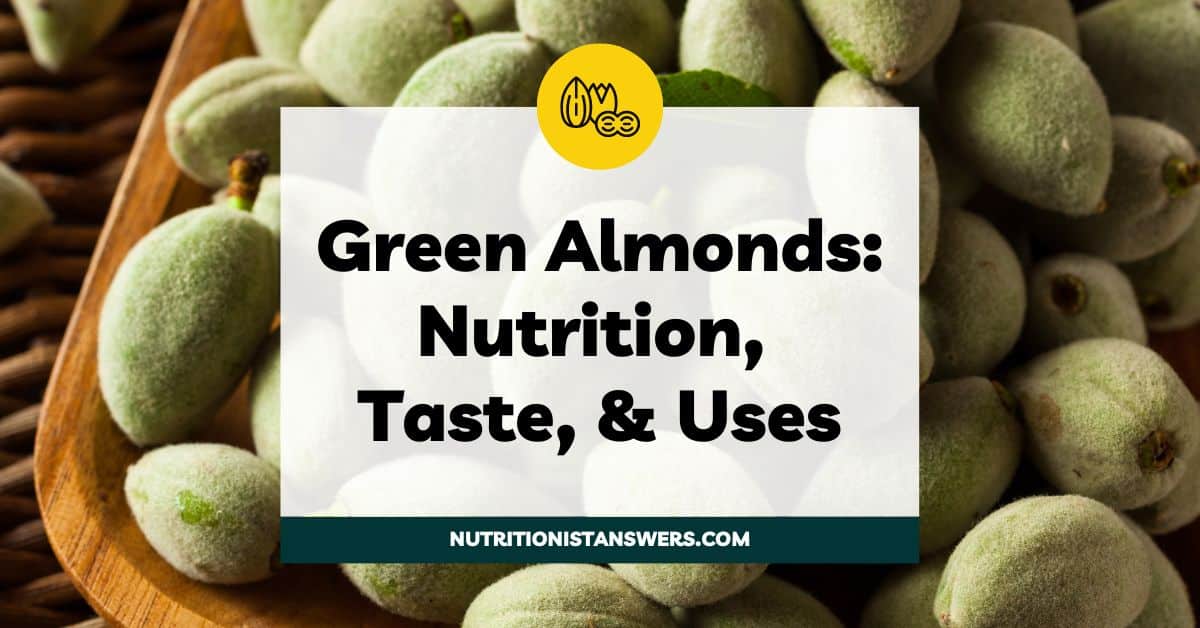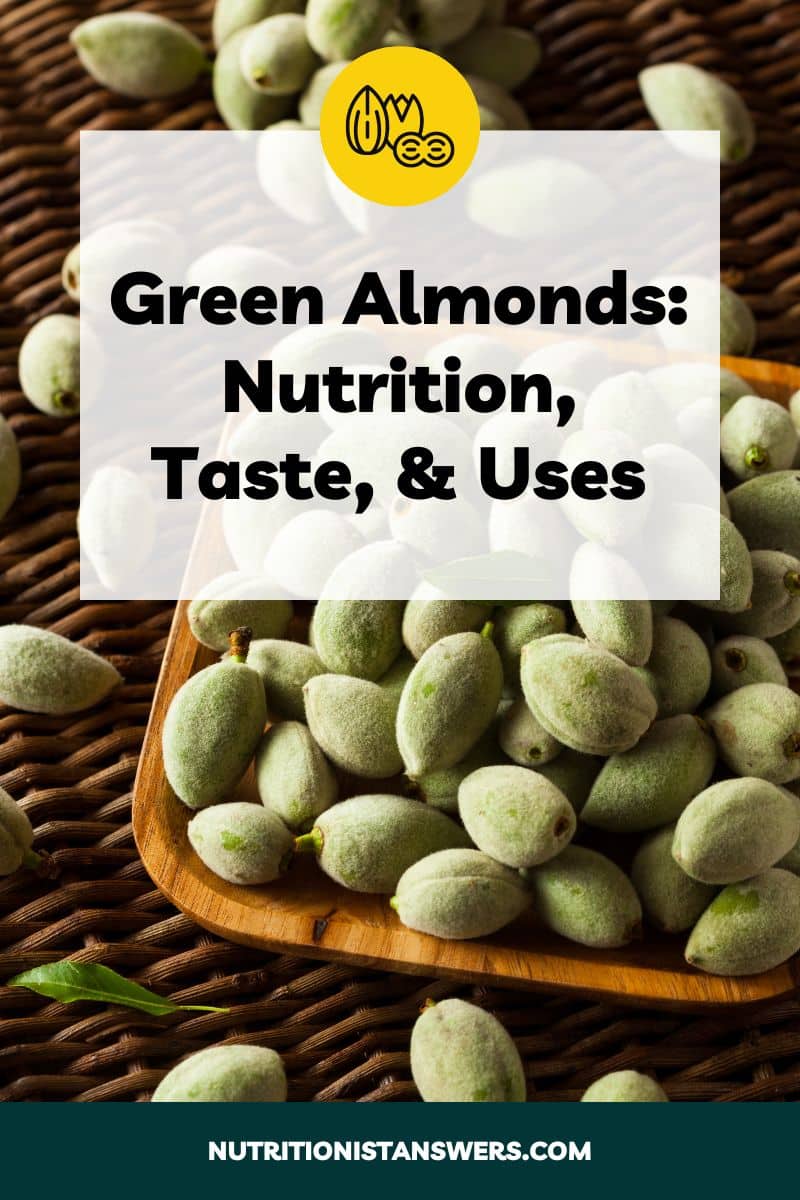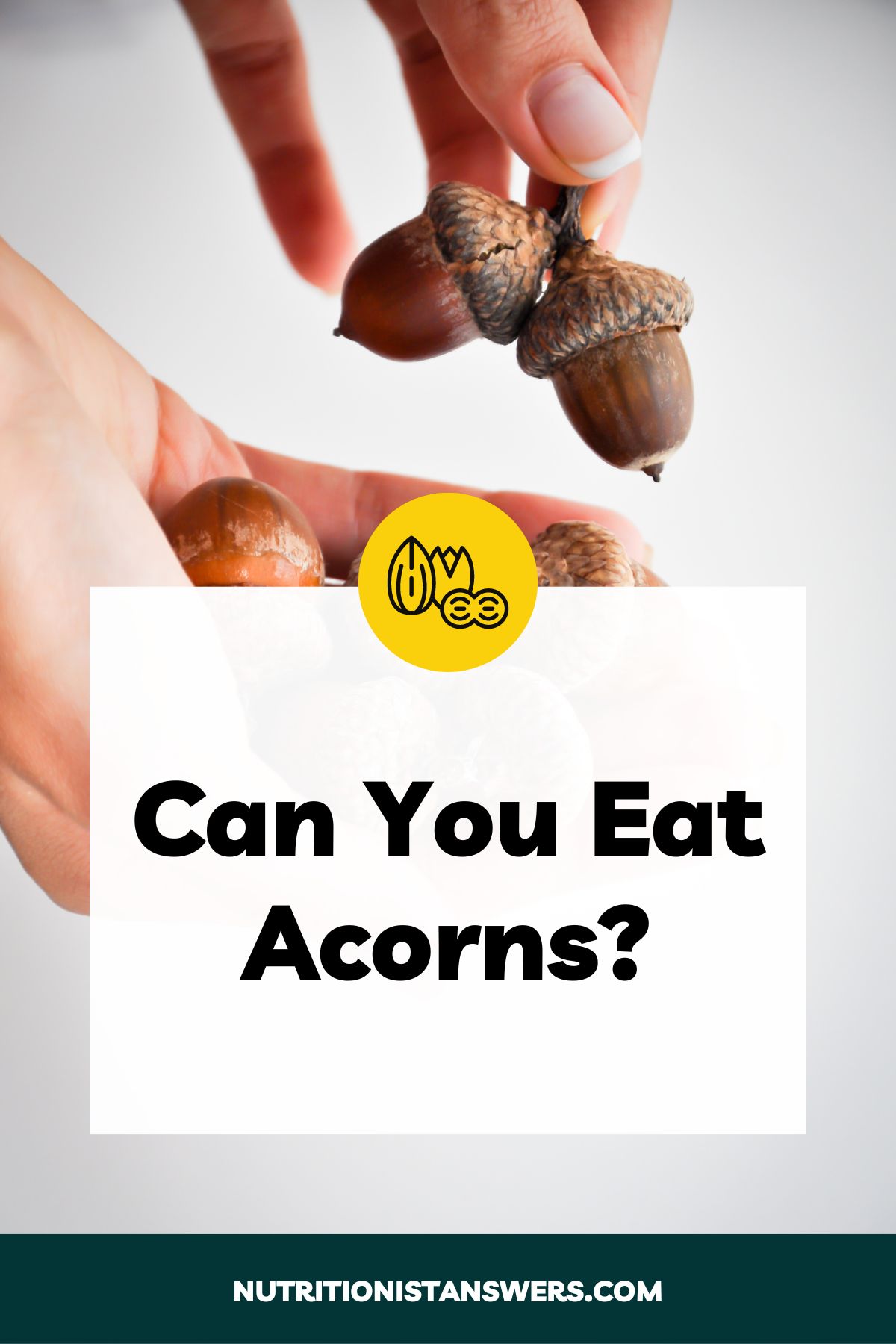If you live near an area where almonds are grown, chances are you’ve seen green almonds popping up at farmers’ markets in the springtime.
These delicacies are a popular seasonal treat, enjoyed for their unique flavor and texture. But you might be wondering, “What are green almonds? And how do they compare to regular almonds?”
In this article, we’ll give you the low-down on green almonds, including nutritional information, where to buy them, and how to use them.

What are green almonds?
Green almonds are simply almonds that have been harvested early in the growing season before they’ve fully matured. At this stage, they appear pale green — hence the name.
These young almonds are about 1-2 inches in length and enclosed in a soft, fuzzy green outer hull that resembles unripe peaches.
Underneath the outer hull, the developing nut is creamy white and soft with a clear, gel-like center. Its texture is similar to a grape or lychee.
Green almonds are a delicacy that has been traditionally consumed for many years in the Mediterranean and Middle East and are now becoming more popular in the United States.
What do green almonds taste like?
Green almonds have a crunchy outer hull that tastes grassy, astringent, and slightly bitter. At the center is a tender nut with a jelly-like interior that tastes mildly floral and tart.
Green almonds nutrition
Green almonds are rich in calories and fat, while also providing a small amount of protein and carbohydrates.
Here’s a more detailed breakdown of green almond nutrition:
Calories and macronutrients
Here’s the calorie and macronutrient content for a 1-ounce (28-gram) serving of green almonds (1):
- Calories: 94
- Carbohydrates: 4 grams
- Protein: 4 grams
- Fat: 7 grams
The nutrition of green almonds is quite different from regular (mature) almonds. Here’s a comparison of the calorie & macronutrient content of green almonds vs regular almonds:
| Nutrient | Green (immature) almonds (1 ounce, 28 grams) (1) | Regular (mature) almonds (1 ounce, 28 grams) (2) |
| Calories | 94 | 164 |
| Carbohydrates | 4 grams | 6 grams |
| Protein | 4 grams | 6 grams |
| Fat | 7 grams | 14 grams |
Compared to regular almonds, green almonds are significantly lower in calories, carbohydrates, protein, and fat. Green almonds have about 40% fewer calories and 50% less fat than regular almonds.
Vitamins and minerals
We couldn’t find any information about the vitamin and mineral content of green almonds.
However, since they are immature versions of regular almonds, they are probably similar to regular (mature) almonds.
Regular almonds are rich sources in vitamin E, providing nearly half of the Daily Value (DV) in a 1-ounce serving. They’re also high in copper, manganese, riboflavin, and magnesium (2).
Green almonds likely contain many of the same vitamins and minerals as regular almonds — just in different amounts. We’ll update this section if new research becomes available.
Antioxidants
Both green and regular almonds are high in polyphenols, a class of chemical compounds with antioxidant properties (1, 3).
Antioxidants protect the body from unstable molecules (called free radicals) that can damage cells and increase your risk for chronic diseases, including cancer and diabetes (4).
Although it depends on the variety, studies show that green almonds tend to have fewer polyphenols and less antioxidant activity than regular almonds (1).
Where to buy green almonds
Green almonds are only available during the spring in areas where almonds are grown. In the United States, California is the main producer of almonds (5).
If you live in or near California, you’ll likely see green almonds at farmers’ markets, and some grocery stores may carry them as well.
However, if you don’t live near any almond orchards, you’ll have to buy green almonds online and have them shipped to your house.
Melissa’s and Frog Hollow are two online retailers that offer green almonds when they’re in season.
How to store green almonds
Green almonds have a very short shelf life — they only last a few days after harvest if kept at room temperature.
To keep them fresh for longer, wrap green almonds in plastic or place them in an airtight container and store them in the refrigerator.
How to eat green almonds
If harvested early in the spring, green almonds are fully edible. Simply remove the stem (if it’s still attached) and pop the almond in your mouth.
However, green almonds that are picked later in the season tend to have tough hulls that can be tough and bitter. Most people choose to remove the green outer hull in this case.
To remove the hull, start by using a paring knife to slice into the hull, stopping when you feel some resistance as the knife hits the inner nut.
Next, cut around the circumference of the almond like you would an avocado, and split it open. In the center, you’ll see a tender nut that can be removed and eaten on its own or used in recipes.
Ways to use green almonds
1. As a snack
Green almonds are typically eaten fresh on their own and dipped in sea salt to enhance their flavor. They make an excellent snack, especially when paired with fruit and cheese.
In Mediterranean and Middle Eastern countries, green almonds are often pickled and served on charcuterie boards and mezze platters.
Green almonds can also be poached in olive oil or water along with seasonings like garlic, chile peppers, herbs, and orange juice or zest.
2. As a garnish
Green almonds can be a beautiful garnish for both sweet and savory dishes.
To use them as a garnish, thinly slice each almond and scatter them over salads, pasta dishes, roasted meats, and even desserts like tarts and ice cream.
Green almonds pair well with a variety of ingredients including lamb, rhubarb, asparagus, artichoke, capers, and fruits.
3. In stews
In Iran, green almonds are traditionally used to make a dish called Khoresh Chaghaleh Badoom (green almond stew).
This delicious stew pairs green almonds with cubed beef, dried limes, onions, turmeric, and fresh herbs, including parsley and mint.
Final thoughts
Green almonds are a spring delicacy known for their unique grassy and sweet-tart flavor and texture that’s both crunchy and gelatinous.
Compared to regular (mature) almonds, green almonds are significantly lower in calories, fat, protein, and carbohydrates.
These delicious young almonds can be eaten on their own or used in a variety of recipes including stews, salads, pasta dishes, and desserts.
If you have access to fresh green almonds during the spring season, give them a try!
Amy Richter is a Registered Dietitian Nutritionist based in Missouri. She is an experienced nutrition writer and medical advisor for Healthline and Medical News Today. Amy is passionate about all things food-related and enjoys translating complex science into easy-to-understand articles.





